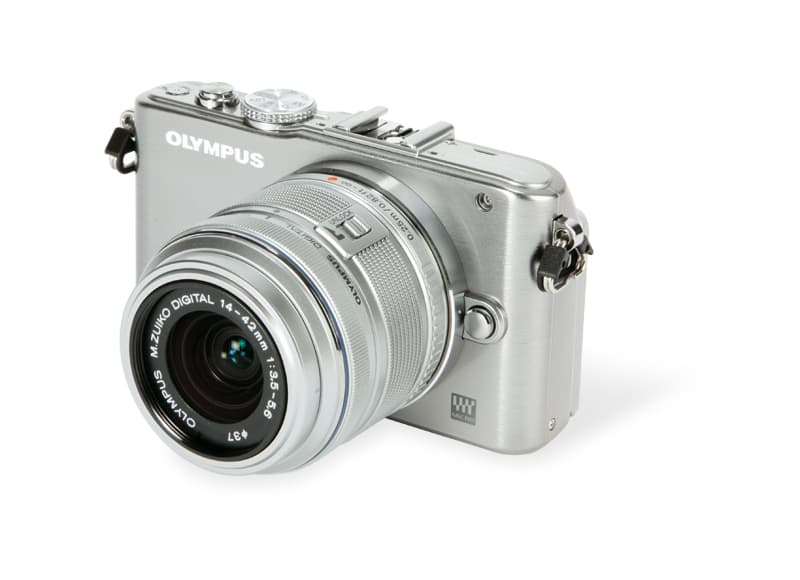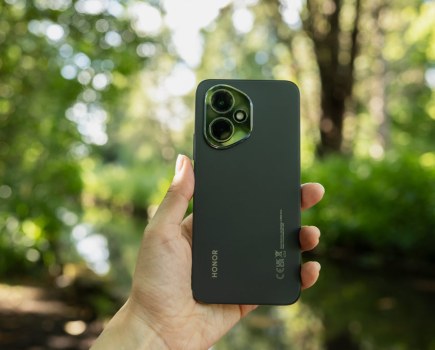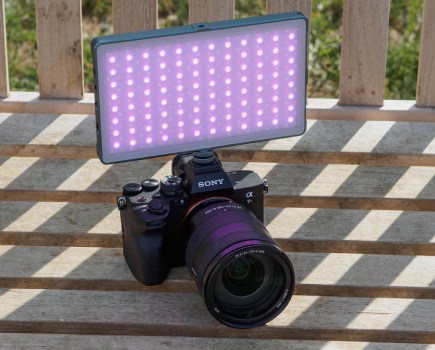Olympus Pen E-PL3 (Lite) at a glance:
- 12.3-million-pixel Live MOS sensor
- Wireless flash control
- 3in, 460,000-dot, tiltable LCD screen
- Available in black, white, silver and red
- Street price around £550 with 14-42mm lens
The micro four thirds market is hotly contested between Olympus and Panasonic. In just over two years we have seen three generations of cameras from both manufacturers.
The digital Olympus Pen range currently includes three cameras, with the E-PL series a continuation of the company’s thrust towards ever-more compact models. The E-PL3 is smaller, lighter and virtually unrecognisable from the classic look of its predecessors, the E-PL1 and E-PL2.
Due to its small size, the E-PL3 is also known as the Pen Lite. The camera loses the built-in flash present on its predecessors, which instead finds its way onto the larger E-P series, specifically the E-P3.
The divide between the two Pen series is growing, it seems. At the same time, Olympus has announced the Pen E-PM1, otherwise known as the Pen Mini.
This model has a much simpler button layout – the absence of a shooting mode dial, for instance – and is therefore designed for those new to photography. It doesn’t feature a tiltable screen, either. Consequently, the E-PL3 offers a good trade-off between the functionality of the E-P3 and the compact size of the E-PM1.
Features
While the E-PL3 uses the same 2.3 million pixels as its predecessors, the sensor is in fact a refined version, claimed to have improved noise performance. As a result, the sensitivity range is extended to ISO 200-12,800. Images are processed using the latest TruePic VI engine, with a JPEG file taking 1sec, a raw file 1.5secs and raw+JPEG combined capture 2secs. The camera can still be used while the images are being processed.
Included among this new model’s refinements is an improved frame rate of up to 5.5 frames per second, for up to eight frames in raw+JPEG and 12 frames in JPEG. Furthermore, focusing is quicker this time around, and the system makes use of full-time continuous AF for near-instant AF in good light. The camera has 35-point AF, which marks a considerable upgrade from the 11-point system found on the previous generation of cameras.
One advantage the Olympus Pen series has over its competition is its capability. With no built-in unit, the wireless system must be controlled using the included external flash or any of the compatible FL-36R, FL-50R or new FL-300R flashguns. The included flash has a guide number of 7m @ ISO 100, which is similar to most built-in flashes and useful for only close-range subjects.
Most cameras these days are flooded with filter effects. The Art Filters from Olympus now offer greater manual control for the user to combine filters and add extra effects such as a border, and to create some interesting and genuinely pleasing results that even hardened photographers should appreciate. Dramatic tone is great for injecting a little punch into scenes with flat light. There is also a new 3D filter mode present, which works by taking two consecutive pictures.
The compact system camera is maturing into an ever-more appealing system as new lenses and accessories are developed. At the time of the E-PL3’s release, Olympus also announced 45mm f/1.8 and 12mm f/2 lenses. The latter is yet another good, sharp pancake optic, perfectly complementing the camera’s compact size. In-camera stabilisation works via sensor shift, so the lenses do not need to include this function.
Build and handling
From an aesthetic point of view, the style of the E-PL3 shows the most significant update of any Pen model. As before, it is available in black, white, silver and red, but the body is smaller and has a distinctly more modern feel. The front surface is smooth and slippery and, with no grip to speak of, the thumb pad on the rear is heavily relied upon.
This slick design is something of a departure from the classic retro feel of an Olympus Pen, and nods more towards the compact Olympus XZ-1. Whether or not this detracts from the camera’s appeal is down to personal taste, but I for one miss the old charm.
 Weighing 265g (body only) and measuring 109.5×63.7×37.3mm, the E-PL3 is the most compact E-PL model yet and virtually the same size as the XZ-1, although a little heavier. A new design does see the lens mount protrude an extra 10mm in depth, however.
Weighing 265g (body only) and measuring 109.5×63.7×37.3mm, the E-PL3 is the most compact E-PL model yet and virtually the same size as the XZ-1, although a little heavier. A new design does see the lens mount protrude an extra 10mm in depth, however.
As already stated, an external flash is included instead of a built-in unit, presumably – as with the Sony NEX-5 – to make the device as small as possible. The flash complements the new style of the camera, and flips up into a forward-pointing position. It connects via a hotshoe and an accessory port, and is able to communicate wirelessly with other flashguns. And the similarities between the E-PL3 and the Sony NEX-5 do not end here: the E-PL3 also introduces a tiltable LCD screen into the Pen range for the first time.
One slight frustration, however, is that the sensor does not correctly orientate the files, so portrait-format images will need rotating post-capture.
White balance and colour
In a variety of conditions, such as bright sunlight, overcast skies and indoor tungsten light, the auto white balance of the E-PL3 gives no cause for concern. For those few situations where it may struggle, taking a custom white balance is simple.
It is in the manual control of white balance and colour that the E-PL3 is really strong. The comprehensive white balance options include Kelvin adjustment, custom settings, the usual six presets and white balance bracketing to maintain warm or cool colours.
I generally stuck to the natural colour mode, which gives a good balance between the vivid and muted colours produced in other colour modes. I also enjoyed using the monotone mode, for which a vast number of filters can be applied for different image types. For example, monochrome with a green filter is ideal for portraits, and the sharpness, contrast and tone of monochrome can then be adjusted, too.
Metering
Like the E-P3, the E-PL3 makes use of a 324-zone, multi-pattern, metering system. This ESP evaluative system provides good exposures within the constraints of the dynamic range, but like most cameras with a smaller sensor, exposures benefit from at least 1/3EV underexposure to maintain extreme highlight detail
Spot metering is available for any of the individually selectable 35 points in the large central area of the frame, with an option for spot metering for a highlight or shadow value. This is good to have considering the slightly more limited dynamic range.


Images: The in-camera Art Filters include the dramatic tone effect, which produces a pseudo-HDR image
Noise, resolution and sensitivity
Like every digital Olympus Pen camera, the E-PL3 features a 12.3-million-pixel Live MOS sensor. Some may consider this a sticking point when compared to some Panasonic Lumix G models, which offer an approximately 16-million-pixel sensor. In reality, only those who regularly view pictures larger than around A3 in size will appreciate the difference.
In raw mode, resolved detail remains at 22 on our charts all the way up to ISO 1600. It only really tails off at ISO 12,800, which, along with ISO 3200 and 6400, is classed as an extended setting. This maximum level of resolved detail is fairly standard for a camera of this level, although the performance at higher sensitivities is good.

Image: The E-PL3 performs well at high ISO sensitivities, and still resolves impressive detail at ISO 1600
Olympus claims that the camera’s new engine combines with the sensor to improve noise performance, when compared to previous Pen models. There are slight signs of luminance noise at ISO 400 and these become particularly noticeable at ISO 1600 and upwards, while chroma noise creeps in at the highest ISO 12,800 setting.

Image resolution chart: These images show 72ppi (100% on a computer screen) sections of images of a resolution chart, captured using the kit lens set to 50mm (75mm equivalent). We show the section of the resolution chart where the camera starts to fail to reproduce the lines separately. The higher the number visible in these images, the better the camera’s detail resolution at the specified sensitivity setting.
Autofocus
An improved 35-point AF system covers a large central area of the frame, making it pretty handy in tracking AF mode. It is easy to select any of these points individually in spot AF via the control wheel.
As we explained in our test of the Olympus E-P3 (AP 13 August), the claim of having the world’s fastest AF does not cover every situation. In good light, the AF is close to instant using the full-time AF mode and a compatible lens. This works on the basis that the camera will often be close to the focus point already. Even so, the system is still impressive.
In lower-contrast light, however, like many AF systems, the contrast-detection AF often needs to hunt back and forth to find the point of focus. In this case, the E-PL3 cannot match the speed of an AF system from a current mid-range DSLR.
LCD, viewfinder and video
The E-PL3 features the first flip-out screen of any digital Pen-series camera, although the resolution remains at 460,000 dots. Without delving into a fully articulated screen versus tiltable screen argument, the benefits of the latter include a sturdy build, quick single-motion positioning and increased subtlety.
The screen is in 16:9 format, which will appeal to video users, but photographers shooting in the highest 4:3 format will experience a black border along the left and right edges. This space is used to contain the shooting options. It is worth checking whether the screen will flip out fully in both directions when the camera is mounted on a tripod. I found the screen particularly useful for discreetly shooting from the hip when photographing street scenes, as well as when holding the camera up over crowds. It is a great improvement over a standard fixed screen.
As with all digital Pen models, there is no viewfinder; instead, an optical or electronic viewfinder can be purchased separately. During my testing I used the VF-1 optical viewfinder, which slots onto the hotshoe easily and suits the body of the camera perfectly. This is a good option when bright light renders the LCD screen too dark to view. A viewfinder is, however, a fairly expensive accessory to buy.
The E-PL3 now offers full HD, 1080i video shooting at 60fps, complemented by stereo sound recording and an option for an external microphone via the microphone adapter set.
Dynamic range
The main sticking point of a smaller four thirds sensor when compared to the larger APS-C format is that the dynamic range is not as wide – typically by at least 2EV.
This extra 2 stops of light captured by the APS-C format is not so much of an issue when a scene has a fairly even tone, but when shooting an overcast landscape, for instance, more highlight detail will be lost if exposing correctly for the midtones.
Verdict
With the core of the Olympus Pen models the same, the E-PL3’s makeover successfully creates a marked physical difference between it and the larger E-P3.
Those desiring a compact and modern-styled body will be happy. A tiltable screen aids handling and, when the camera is used with a sharp pancake lens, it is not only great fun but also produces good-quality images.








